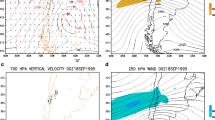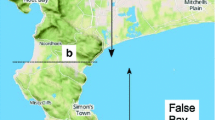Abstract
An innovative methodology aimed at establishing a numerical model-based high-resolution climatology of extreme winds over Switzerland is described, that makes use of the Canadian Regional Climate Model where a new windgust parameterization has been implemented. Self-nesting procedures allow windstorms to be studied at resolution as high as 2-km. The analysis of ten major windstorms concludes that the average spatial pattern and magnitude of the simulated windspeeds are well captured, and the areas that experienced extreme winds correspond well with observations and to the location where forest damage was reported following the last two of these storms. This climatology would eventually serve to form risk assessment maps based on the exceedance of windspeed thresholds. There is, however, a need for further investigations to encompass the full range of potential extreme wind cases. The ultimate goal of this methodology is to assess the change in the behaviour of extreme winds for a climate forced by enhanced greenhouse gas concentrations, and the impact of future windstorms over the Alpine region at high resolution.




Similar content being viewed by others
References
Bantle H (1989) Program documentation for the Swiss climate data base at the computing center of ETH-Zürich. MeteoSuisse publication, Zürich, Switzerland (in German)
Barry RG (1992) Mountain weather & climate. 2nd edn. Chapman and Hall, Inc, Routledge, 402 pp
Beniston M, Stephenson DB, Christensen OB, Ferro CAT, Frei C, Goyette S, Halsnaes K, Holt T, Jylhä K, Koffi B, Palutikof J, Schöll R, Semmler T, Woth K (2006) Future extreme events in European climate: an exploration of regional climate model projections. Climatic Change (in press)
Beniston M (2003) Climatic change in mountainous regions: a review of possible impacts. Climatic Change 59:5–31
Beniston M, Innes J (eds) (1998) The impacts of climate variability on forests. Springer-Verlag, Heidelberg/New York, 329 pp
Benoit R, Desgagné M, Pellerin P, Pellerin S, Chartier Y (1997) The Canadian MC2: A semi-Lagrangian, semi-implicit wideband atmospheric model suited for finescale process studies and simulation. Mon Weather Rev 125:2382–2415
Biner S, Caya D, Laprise R, Spacek L (2000) Nesting of RCMs by imposing large scales. 7.3–7.4. In: Research activities in atmospheric and oceanic modelling, WMO/TD–No. 987, Report No. 30
Caya D, Laprise R (1999) A semi-implicit semi Lagrangian regional climate model: the canadian RCM. Mon Weather Rev 127:341–362
Christensen JH, Carter TR, Giorgi F (2002) PRUDENCE employs new methods to assess European climate change. EOS 83:147
Christensen OB, Christensen JH, Machenhauer B, Botzet M (1998) Very high-resolution regional climate simulations over Scandinavia––Present climate. J Clim 11:3204–3229
Dobbertin M (2002) Influence of stand structure and site factors on wind damage comparing the storms Vivian and Lothar. Forest Snow and Landscape Research 77:187–205
Dorland C, Tol RSJ, Palutikov JP (1999) Vulnerability of the Netherlands and Northwest Europe to storm damage under climate change. Climatic Change 43:513–535
Goyette S, Brasseur O, Beniston M (2003) Application of a new wind gust parameterisation. Multi-scale case studies performed with the Canadian RCM. J Geophys Res 108:4374–4390
Goyette S, Beniston M, Caya D, Laprise JPR, Jungo P (2001) Numerical investigation of an extreme storm with the Canadian Regional Climate Model: the case study of windstorm VIVIAN, Switzerland, February 27, (1990). Clim Dyn 18:145–178
Gyalistras D (2003) Development and validation of a high resolution monthly gridded temperature and precipitation data set for Switzerland (1951–2000). Clim Res 25:55–83
Hanson CE, Holt T, Palutikof JP (2004) An integrated assessment of the potential for change in storm activity over Europe: implication for insurance and forestry in the UK. Tech. Rep. 12, Tyndall centre for Climate Change Research, Univ. East Anglia, UK, 98 pp
Hoinka KP (1985) Observation of the airflow over the Alps during a foehn event. Quart J R Met Soc 111:199–224
Jungo P, Goyette S, Beniston M (2002) Daily wind gust speed probabilities over Switzerland according to three types of synoptic circulation. Int J Climatol 22:485–499
Kalnay E, Kanamitsu M, Kistler R, Collins W, Deaven D, Gandin L, Iredell M, Saha S, White G, Woollen J, Zhu Y, Leetmaa A, Reynolds B, Chelliah M, Ebisuzaki W, Higgins W, Janowiak J, Mo KC, Ropelewski C, Wang J, Jenne R, Joseph D (1996) The NCEP/NCAR 40-years Reanalysis project. Bull Amer Meteor Soc 77:437–471
Laprise R, Caya D, Bergeron G, Giguère M (1997) The formulation of the André Robert MC2 (mesoscale compressible community) model. Atmos Ocean 35:195–220
Laprise R, Caya D, Giguere M, Bergeron G, Côté H, Blanchet J-P, Boer GJ, McFarlane NA (1998) Climate and climate change in Western Canada as simulated by the Canadian regional climate model. Atmos Ocean 36:119–167
McFarlane NA, Boer GJ, Blanchet J-P, Lazare M (1992) The Canadian climate centre second generation general circulation model and its equilibrium climate. J Climate 5:1013–1044
Nilsson C, Goyette S, Bärring L (2006) Relating forest damage data to the wind field from high resolution RCM simulations: case study of Anatol striking Sweden in December 1999. Global Planet Change (in press)
Pope DV, Gallani M, Rowntree R, Stratton A (2000) The impact of new physical parameterizations in the Hadley Centre climate model HadAM3. Clim Dyn 16:123–146
Sanders F, Gyakum JR (1980) Synoptic climatology of the “bomb”. Mon Weather Rev 108:1589–1605
Schüepp M, Schiesser HH, Huntrieser H, Scherrer HU, Schmidtke H (1994) The winterstorm “VIVIAN” of 27 February 1990: about the meteorological development, wind forces and damage situation in the forests of Switzerland. Theor Appl Climatol 49:183–200
Tanguay M, Robert A, Laprise R (1990) A semi-implicit semi-Lagrangian fully compressible regional forecast model. Mon Weather Rev 118:1970–1980
Tveito OE, Schöner W (eds) (2002) Applications of spatial interpolation of climatological and meteorological elements by the use of geographical information systems (GIS). Cost 719, Rep. 28/02. Norweg. Met. Inst, Blindern, Oslo, Norway, 44 pp
Wanner H, Furger M (1990) The Bise––Climatology of a regional wind north of the Alps. Meteorol Atmos Phys 43:105–115
Acknowledgments
This study has been partially funded by NCCR-Climate program of the Swiss National Science Foundation (grant No. FN-7449). The author would like to thank Prof. M. Beniston for his constructive comments to this manuscript as well as to the two reviewers for help to improve and clarify the text.
Author information
Authors and Affiliations
Corresponding author
Rights and permissions
About this article
Cite this article
Goyette, S. Development of a model-based high-resolution extreme surface wind climatology for Switzerland. Nat Hazards 44, 329–339 (2008). https://doi.org/10.1007/s11069-007-9130-5
Received:
Revised:
Accepted:
Published:
Issue Date:
DOI: https://doi.org/10.1007/s11069-007-9130-5




